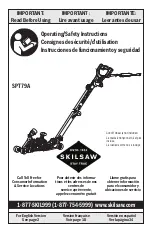
16
GLASS INSTALLATION AND GLAZING
This section applies only if you need to install glass for
any reason or if glass setting blocks need to be adjusted.
Proper glass installation is critical, as, with the NanaWall
folding system, glass is a structural part of the panel.
Glass stops and glazing gasket are to be used for “dry”
glazing of each panel. Also needed are setting blocks.
Use glass setting blocks with varying thickness made
from
hard plastic. Rubber setting blocks are not
acceptable.
Width of setting blocks should be at least 1/8
"
wider than the glass thickness and 1/16
"
to 1/8
"
less than
the width of the glazing pocket.
Glass, with appropriate dimensions, thickness and
specifications will be needed. Depending on the model,
widths of all glass panels may not be equal. Please note
that glass is required to be fully tempered unless the unit
is a window placed above a certain height from the floor.
Check with all applicable codes and regulations.
Float glass, including the glass components of insulated
glass, shall meet the current requirements of ASTM C
1306 “Standard Specifications for Flat Glass” for quality,
thickness and dimensional tolerances. Tempered float
glass shall meet the current requirements of ASTM C
1048 “Standard Specifications for Heat-Treated Flat
Glass - Kind HS, Kind FT Coated and Uncoated Glass.”
All tempered glass shall have a permanent logo, which
signifies Safety Commission 16 CFR-1201 and the safety
glass test requirements of ANSI Z 97.1 (current editions).
Insulating Glass shall meet the requirements of ASTM E
774, Class A, B or C.
Although glass installation with the “dry” glazing system
is relatively straight forward, it is recommended that an
experienced glazing contractor be used.
It is
very important
that the bracing direction and
placement of glass setting blocks on opposite diagonal
corners be correct. Setting blocks are to be placed only
at opposite diagonal corners with corners alternating with
each succeeding panel. This is necessary for the stability
and balance of the panels when in operation. If not
correctly braced, the unit will not operate properly.
The general rules for bracing are as follows:
• For a panel attached to a side jamb, the lower brace
should be at the lower corner closest to the side.
• For a panel with a running carriage, the lower brace
should be on the lower corner that is on the same
side as the running carriage.
• For a swing panel, the lower brace should be at the
lower corner away from the stile with the locking
hardware. See Diagram 1 for an example of setting
block locations.
Follow all proper applicable glass installation and glazing
techniques as recommended in the Flat Glass Marketing
Association (FGMA) “Glazing Manual” and “Sealant
Manual”. Always use suction cups to shift glass within an
opening. It would be best to install the glass on the panels
before they are installed in the opening. Panels can be laid
flat on sawhorses. If the panels are already installed, they
can still be glazed.
1.
Close all panels and secure them with the multiple
point lock bolts. Start with a panel that is attached to
a side jamb or, in the case of unhinged pairs, closest
to a side jamb.
2. Remove all glass stops on the panel. Be sure to
protect the finish.
APPENDIX A
NANAWALL WD65 OWNER’S MANUAL








































